Lal Qila and Jama Masjid
Lal Qila and Jama Masjid
Lal means red in Hindi, and Qila means fort. To English speakers, this is known as Red Fort. Jama means Friday in Arabic, and Masjid means mosque. English speakers call it the Great Mosque. Close enough.
Click once on any photo to open the large format scroll of all images on the page.
UPDATE:
We enjoyed a second visit to Lal Qila (Red Fort) with our friend, Aimée, who is visiting from Singapore. We did not take many new photos of the sights....just photos of our new friends. Well, really, this is something folks like to do in India....have their photo taken with strangers. It leads to many enjoyable moments and kind exchanges.
A portion of the marble screen has been replaced. I wonder how long before the air begins to discolor the lovely white stone. Marble is fragile and susceptible to dissolution by the acids in city air.
At the end of sightseeing, we enjoyed lunch a Bikanervala restaurant and visited their sweets counter for something to take home to enjoy with coffee. Nice day out!
March 19, 2019
These are two of the prominent landmarks in Old Delhi.
This documentary provides context: The Great Mughals (1990)


A Sikh temple in the distance.
The entrance takes visitors through the Chhatta Chowk, a covered marketplace since the 17th Century for silver jewelry and other valuable trinkets. It is modeled after the bazaars of Pakistan and the gate here is named the Lahori Gate, after the neighboring country's second city. According to the information panel, this style of marketplace is not common at all in India.

People in India love to have their picture taken with strangers, mainly foreigners, I think. It seems to surprise some of them when we take out our cameras and insist on the same. Of course, they oblige, but sometimes with a curious wrinkle of the lip.

The interior surfaces are faced with marble inlaid with semi-precious stones, as is common in Mughal period architecture, as well as painted plaster.
Something went wrong with these "slo-mo" videos, but they show the proportions of the Diwan I Khas, the Emperor's private audience hall and personal rooms near his own mosque, the Moti Masjid.
More selfies with strangers. Our attitude threw her off, as well. I don't think it usually happens that strangers want to get in on the game.

Lal means red in Hindi, and Qila means fort. To English speakers, this is known as Red Fort. Jama means Friday in Arabic, and Masjid means mosque. English speakers call it the Great Mosque. Close enough.
Click once on any photo to open the large format scroll of all images on the page.
UPDATE:
We enjoyed a second visit to Lal Qila (Red Fort) with our friend, Aimée, who is visiting from Singapore. We did not take many new photos of the sights....just photos of our new friends. Well, really, this is something folks like to do in India....have their photo taken with strangers. It leads to many enjoyable moments and kind exchanges.
All kinds of new friends!
We agreed that the marble inlaid with semi-precious stone makes the most beautiful flowers anywhere.
My new buddies, the American tourist needing sunscreen and the policeman from Haryana, north of Delhi. Very kind fellows, both.
March 19, 2019
These are two of the prominent landmarks in Old Delhi.
This documentary provides context: The Great Mughals (1990)


There were separate ticket windows and waiting lines for women and men.
Just looking, not buying today.

People in India love to have their picture taken with strangers, mainly foreigners, I think. It seems to surprise some of them when we take out our cameras and insist on the same. Of course, they oblige, but sometimes with a curious wrinkle of the lip.
Some dress with elegance, some for comfort.
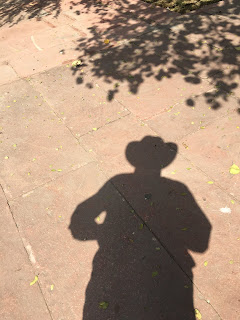 |

My shadow seeking shade. It's starting
to feel like summer in Delhi.
Glass panels protect the 400 year old surface that was plastered and painted with vegetable and floral motifs, so common to Mughal architecture. It is wonderful to see these fragments of the original work.
The plaster is a good 3/4 inch thick, but it has crumbled from most surfaces. Much of the current surface was restored in 1911, and that also shows weathering and wear and tear in many places.
The restored surfaces attempt to reproduce the original.
Flowering plants are by far the most frequently used motif throughout the Lal Qila complex.
Behind Diane, the restored and glass-fronted original surfaces can be seen.
On hot days, the cool interiors cause a breeze to flow through the halls and archways.
The emperor heard appeals from his subjects from this very ornate marble divan.
The glass case protection makes photography difficult in the bright light. Of course, for visitors these days, it's another great selfie opportunity. Nothing wrong with that!
The Mumtaz Mahal honored and provided rooms for Shah Jahan's favorite wife, Mumtaz Mahal. The structure is currently being renovated, so any closer approach was prohibited. The guide book says that the roof and eaves were once very ornate, but that they were removed for their precious metals in subsequent centuries. The same is true of the next Mahal, which featured a silver ceiling that was replaced by copper and then wood as later emperors were short of resources.
Who is Mumtaz Mahal? Mahal means palace and Mumtaz means exalted one. "Exalted one of the Palace," if it seems like a bit of a stage name, it is; a royal name taken upon her marriage to the emperor, that is. She was born Arjumand Banu Begum, the daughter of a mid-level Persian noble in Agra. Mumtaz Mahal bore fourteen children to the emperor, Shah Jahan, so one may assume they were very fond of one another. Shah Jahan later built the Taj Mahal as her tomb, and it is said he missed her so greatly that he fell into apathy and would be easily imprisoned and deposed by his sixth son. Indeed, he lived out the last years of his life as a prisoner in a small set of chambers in Agra's Old Fort overlooking the Ganges and his beloved Taj Mahal.
It is Shah Jahan who moved India's capital from Agra to Delhi in 1639 because the climate was much milder. He maintained a residence in Agra and planned the burial place for his dear wife and himself there. Events conspired such that a brief imprisonment there was added into those plans.
A lovely floor-level fountain. For many years, it was covered by similar large paving stones that surround it now. The entire area is inaccessible due to its fragility. Good idea!
A variety of tourists.
This slo-mo is working.
They got me, and I got them. We shared a knowing nod and smile.
I thought Diane was trying to pick the lock and enter the Moti Masjid. She just got some good shots through the opening in the doorway.
A fine copper door it is.
I'm into birds lately. These are the local kite-hawks. Their populations must reach the millions in Delhi. They are everywhere.
The domes of the Moti Masjid.
Administrative buildings of the British era now house the Red Fort Museum.
]
The Streets of Old Delhi
"Slo-mo" is the opposite of the reality.

Late lunch out at the Fez restaurant in Malcha Marg capped off the outing in a delicious and restful manner.














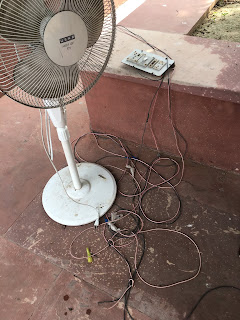

















































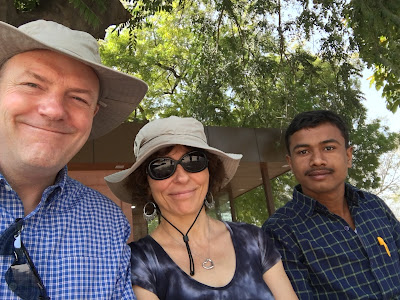







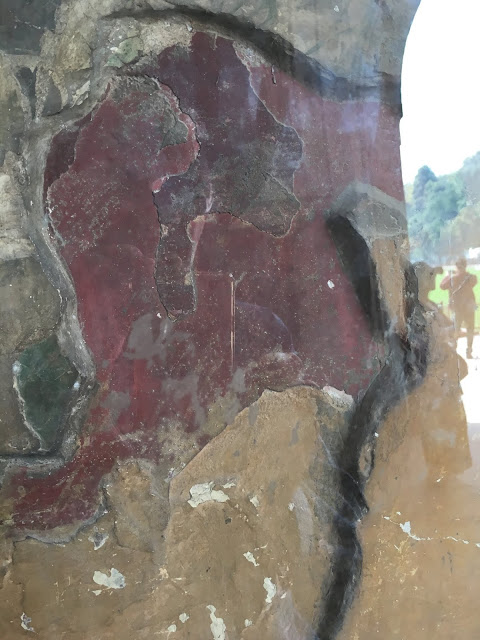



















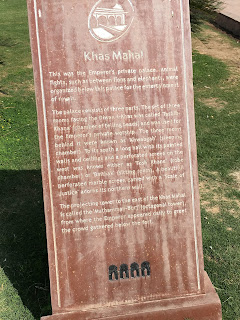








































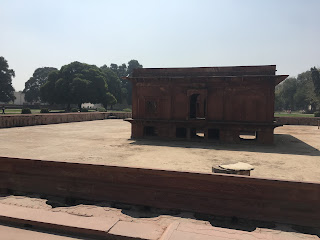

































































Comments
Post a Comment